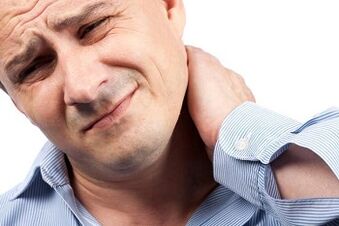
The tendency to increase degenerative-district lesions of the spine is steadily increasing every year, and everything because the problem of hypodynamia and hypokin is acute due to urbanization.Damage to the cervical spine causes frequent, different intensities of headaches and a feeling of stiffness in the neck and forearm.Today our theme is the causes, symptoms and treatment of osteochondrosis of the cervical region.
Reasons for the development of cervical osteochondrosis
Speaking of the causes of degenerative damage to the cervical, genetic, toxic, metabolic, endocrine, infectious, and others can be listed.However, in the first place you can put a sedentary lifestyle and sit on the computer, table and driving.
Frequent stresses that involuntarily make stoop behavior, which leads to violations of nerve neck blood vessels, help to help this pathology.
Symptoms of neck pain should not be ignored, as this leads to the progression of the disease and the development of complications such as periartosis that brings shoulders, vertebral artery syndrome, anterial staircase syndrome and roying syndrome.
In relation to the anatomical structure
Now let's see which anatomical and physiological traits of the cervical back structure contribute to the development and progression of osteochondrosis:
- The cervical department is the most removable section of the spinal column.Since all types of movements are possible in it, this increases the risk of subluxation and frequent violations;
- The vertebral artery develops in the canal formed in the holes of the transverse processes of the vertebrae.Is the blood of the brain, hearing organs, spinal nerves and cerebellum.With the development of degenerative-district changes, artery and nerve can be caught in this department.
- In the cervical region, the intervertebral discs are not everywhere between the vertebrae.At the front, the beads are connected to the joints, which can provoke the subluxation of the joints.
- The holes in the three lower cervical vertebrae have a triangular shape, and with the growth of bone tissue with osteochondrosis, the nerve roots can violate.
- Along the cervical department, vegetative ganglia is located.
These features will help us present the mechanism for developing the complications of cervical back osteochondrosis.
Mechanisms for developing changes in the cervical spine

The pathological process begins on the intervertebral disc with the loss of moisture with a pulposa disc core.The fibrous disc ring is gradually becoming thinner, its elasticity decreases and microwaves appear.
As a result, the disk loses its ability to regulate, depreciate and support.The load on the lower beads gradually increases, after which the vertebra itself is involved in the process.
Small defects appear in it and osteophytes (excess bone growth) are increasing to withstand an increased load.
With the growth of bone tissue, the nerve roots are squeezed along the posterior wall of the vertebra, and if on the lateral surface, the vertebral artery is violated.
Subluis in the joints occur due to a violation of stability between the vertebrae.This leads to compensatory tension of the neck muscles, which helps maintain cervical vertebrae in a normal position.
When the muscles get tired, the load on the beads increases again, which leads to the progression of the disease.Thus, a wicked circle is formed in which spasmodic muscles and damaged vertebrae adversely affect each other and lead to a deterioration in the patient's condition.
Based on pathological mechanisms, symptoms of the disease are formed.So, squeezing the nerve roots is manifested by intense paroxysmal pain along the violated nerve.
And when compressing vertebral arteries, the symptoms associated with a decrease in blood flow to the brain, namely: ears noise, dizziness and headaches, appear in the first place.
The main symptoms of cervical osteochondrosis.
The main symptoms of cervical osteochondrosis are conditionally divided into 3 groups:
First group of symptoms - pain
It manifests in the form:
- local pain in the back of the head/neck;
- By radiating the pain, which lies on the right or left hand, and can also go to the fingers, brush, forearm and even localize to the shoulder joints.
This pain can be painful and persistent, irritating and spreads throughout the neck or hand.Or is a more acute local pain that appears as a result of the nerve root cracks.
The second set of symptoms is motor disorders
First of all, it is the stiffness of the neck and nap muscles, as a result of which it is impossible to turn or turn your head normally, or make any movement in the cervical back.
Moreover, this is a restriction of mobility in the shoulder joint, which is called the shoulder periartrosis syndrome.It is also possible to spread throughout the hand, including numbness of the fingers, numbness of the hands and numbness along the lateral surface of the shoulder or forearm.
The third set of symptoms is vegetable manifestations, manifestations from vessels
In the process of this, a spasm of blood vessels or pinching occurs on the back.As a result, such symptoms of cervical osteochondrosis can appear as headaches, dizziness, ignition of "flies" in front of the eyes.
There may also be hearing damage - the noise in the ear and the feeling of a "sulfur plug", in which a person does not hear well.These symptoms belong to vertebral artery syndrome.
Methods of traditional treatment of cervical osteochondrosis

Modern medicine offers many methods for the treatment of degenerative-district lesions of the spine.Among them, they distinguish: drug treatment, manual therapy, folk remedies, physical therapeutic culture (exercise therapy) and in distant cases that turn to surgical treatment.The effectiveness of therapy depends on what stage the treatment and a complex of selected methods have begun.
Treatment should first of all aim to normalize the cervical muscle tone.The action of other means is aimed at removing inflammation and pain in the area of developing pathological changes.
An important point in the treatment of osteochondrosis is a good comfortable dream that experts recommend using an orthopedic pillow.
In the early stages of developing the disease, the use of massage in an experienced specialist and self -massage will be effective.This method will help to relax spasmodic muscles and stop the progression of the pathological process.
Physical education
The treatment of osteochondrosis should include physiotherapy exercises in the form of therapeutic or morning hygienic gymnastics.When performing a complex of treatment exercises, respect the following recommendations:
- Wear comfortable clothes and shoes;
- in order not to lack shortness of breath, alternative exercise of ordinary breathing;
- The load should be increased gradually, and if you start complaining from the cardiovascular system during the lesson, then stop the exercise and seek advice to your doctor;
- If the pain appeared on the cervical back during the lesson, then replace them with relaxation and stretch exercises;
- During the lesson, check your overall well -being, breathing and pulse;
- If hand and load exercises cause you pronounced pain, then for a while, abandon them;
- The complex of the physical exercise of therapeutic exercises should agree with the doctor.

The following effects are expected from physiotherapy exercises:
- By strengthening the neck muscles,
- Restoration of blood flow;
- Increased motility of vertebrae;
- Increased volume of movements in the cervical region;
- Getting rid of the pain and restoration of intrigue;
- Preventing irritation.
Treatment
Most neuropathologists and other experts do not represent the treatment of cervical spine osteochondrosis without medication.The most popular are medicines from a group of non -steroidal anti -inflammatory drugs (NSAIDs), which are used in the form of injections, tablets, gels and ointments.
Non -steroidal anti -inflammatory drugs relieve pain, inflammation and relieve swelling, as a result, the neck muscle tone is restored, metabolism in the affected area improves, and nerve roots and blood vessels are released from compression.
It is advisable to use medicines from a relaxing muscle group, which also effectively relieve muscle spasm and at the same time restore their tone.However, medicines should be used with caution, especially in allergies.

Preparations from the corticosteroid group have gained good estimates in the treatment of cervical spine osteochondrosis.
The injection drug is very popular due to its anti -inflammatory and neuroprotective effects.
If the prescribed treatment is not effective, then they are directed to the use of the preverstebral block with the sedative or steroids.
How to treat cervical osteochondrosis with non -traditional methods
Proponents of non -traditional treatment methods may use the following methods of treatment.
- AcupunctureIt helps to save the patient from pain, relieve swelling and relax spasmodic muscles, as well as eliminate functional squeeze of nerves and arteries.If the fingers are numb in the hands, it is advisable to place the needles at the biologically active points in the arm and ear sink;
- Manual therapyIt helps to restore normal blood flow to the neck, relieves muscle spasm and releases nerves.The extension of the spine should be performed by a very carefully skilled specialist;
- Hirudotherapy (Treatment with Lech)It is a free treatment method and quite effective.The procedure consists of placing rows for biologically active points, which must be repeated by a course of 10 sessions.This method helps to restore blood circulation in the cervical region, relieve swelling and inflammation;
- MassageIt consists of the effects of the finger on active biological points and helps relieve muscle spasm, improve blood circulation, relieve swelling, pain and inflammation;
- Popular methods of treatmentYou can use it successfully at home.These are different decoctions and infusions that can be prepared on their own (worm infusion, lilac infusion, garlic infusion).Therapeutic baths made by mint, chamomile, sage, calamus rhizomes have a good effect.

After the above methods of treatment and familiarity with the mechanisms of developing the disease, make a decision for which you contact your own problem: to a neuropathologist or private clinic.

















































